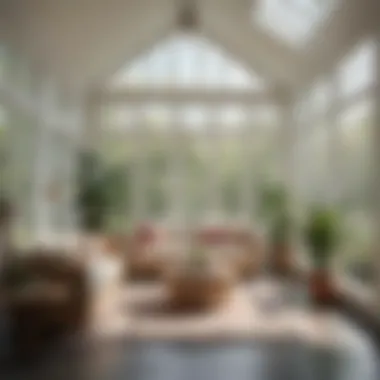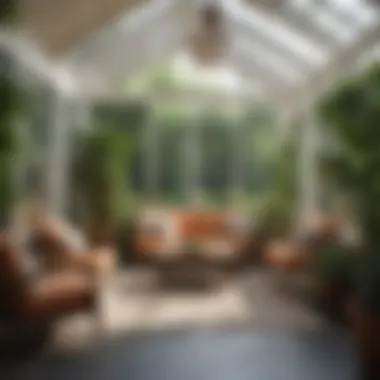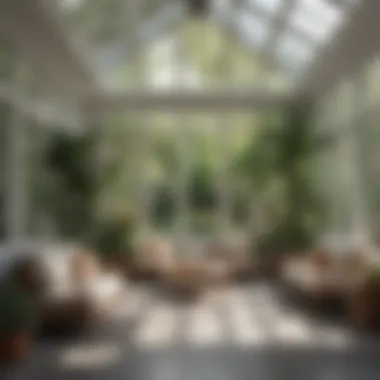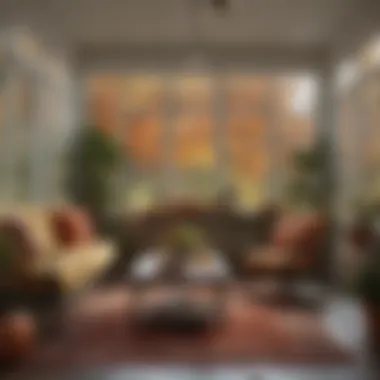Exploring the Front Sunroom: Design and Functionality


Intro
In our pursuit of creating inviting and functional living spaces, the concept of a front sunroom presents a fascinating opportunity. This article explores the significance of front sunrooms, focusing on their design, functionality, and vital considerations. A well-designed sunroom not only enriches the aesthetic appeal of a home but also serves practical purposes throughout the year. This exploration aims to guide homeowners and design enthusiasts towards optimizing their living environments by understanding the nuances of sunroom integration.
Design Inspiration
Creating a front sunroom involves careful thought in design. This space should harmonize with the overall architecture of the home while also reflecting personal taste.
Current Trends in Interior Design
Current trends emphasize the seamless blend of indoor and outdoor environments. Front sunrooms are increasingly designed to maximize natural light and connect with the surrounding landscape. Popular design elements include:
- Large glass panels to enhance light penetration
- Open floor plans to create airy spaces
- Natural materials like wood and stone for a warm feel
Homeowners are often looking for ways to integrate modern technology, such as smart glass options that adjust to sunlight intensity.
Color Schemes and Palette Ideas
Choosing the right color scheme can profoundly impact a front sunroom's atmosphere. Soothing greens, soft blues, and earthy tones can create a tranquil retreat. Consider using:
- Light pastels for a calming effect
- Bold accents to add character
- Complementary shades to tie in with the rest of the home’s decor
Ultimately, the choice of colors should evoke comfort and tranquility.
Gardening Techniques
For those passionate about gardening, a front sunroom offers an excellent platform for cultivating plants. The management of plant life in this space requires an understanding of specific gardening techniques to thrive.
Plant Selection and Care
When selecting plants for a sunroom, consider light conditions and humidity levels. Some great options include:
- Fiddle leaf figs for dramatic foliage
- Peace lilies for low-light areas
- Herbs like basil and mint for culinary enthusiasts
Regular maintenance is key. This includes scheduled watering, appropriate fertilization, and ensuring proper drainage.
Indoor vs. Outdoor Gardening
A front sunroom blurs the lines between indoor and outdoor gardening. Homeowners might consider:
- Indoor gardening for plants that thrive in controlled conditions
- Outdoor gardening for seasonal plants during optimal months
This versatility allows for experimenting with a diverse range of flora, enhancing both the aesthetic appeal and functionality of the sunroom.
"A front sunroom not only extends living space but also fosters a unique connection with nature in a home."
Understanding these elements can lead to a successful sunroom that serves both aesthetic and functional purposes. By considering design inspiration and gardening techniques, homeowners can effectively curate a space that reflects their vision and enhances their lifestyle.
Preface to Front Sunrooms
The inclusion of front sunrooms in residential design has become increasingly relevant. Homeowners and designers recognize these spaces not only for their aesthetic contributions but also for their functional capabilities. Front sunrooms serve as transitional areas between exterior and interior, creating a unique welcoming environment.
In this article, we will explore various dimensions of front sunrooms, focusing on the aspects that enhance both their design and practicality. Understanding what a front sunroom involves, its historical significance, and its benefits can greatly influence decisions for homeowners looking to optimize their living spaces.
Definition and Overview
A front sunroom is defined as a room that is usually constructed with a significant amount of glass and located at the front of a house. This design facilitates an abundance of natural light, making the space bright and inviting. Generally, sunrooms are designed to function as extensions of the home, providing a unique area for various activities ranging from relaxation to entertaining guests.
The structural features of a front sunroom can include large windows, skylights, and sometimes, insulated glass doors that allow for easy access to the exterior. Moreover, they can become a valuable asset by offering a view of the garden or street while creating a barrier from the elements.
Historical Context
Historically, sunrooms date back several centuries. The concept can be traced to the Victorian era, during which homes incorporated glass conservatories. These spaces were designed to showcase plants and flowers, becoming popular in affluent households. Today, the evolution of sunrooms has led to various designs that cater to different architectural styles, ranging from traditional to modern.
As building materials advanced, so did the feasibility of creating larger, more effective sunrooms. Techniques in glass manufacturing improved, allowing for better insulation and durability. This progress opened up new possibilities in design, making sunrooms an increasingly common feature in homes.
Additionally, in today’s real estate market, sunrooms are considered attractive to potential buyers. They represent indulgence and comfort, serving as prominent selling points in listings. Thus, understanding both the historical significance and modern relevance of front sunrooms enhances the overall appreciation for such spaces.
Design Elements of Front Sunrooms
The design elements of front sunrooms play a crucial role in determining both their aesthetic and functional impact on a home. These elements encompass a variety of aspects, ranging from architectural styles to materials and lighting. Each factor contributes significantly to how a sunroom can enhance living space, promote comfort, and integrate with the existing home design.


Architectural Styles
Traditional
Traditional sunroom designs feature symmetry and classic details that reflect historic architectural principles. They often include intricate moldings, wooden frames, and abundant windows. The key characteristic of traditional sunrooms is their craftsmanship. This style is beneficial for homeowners who wish to maintain a classic look in alignment with the rest of their property. A unique feature of traditional sunrooms is the integration of charming details like built-in benches. These can provide added comfort and a sense of warmth, although they often come with higher maintenance needs due to wooden materials.
Modern
Modern sunrooms break away from ornate features, emphasizing simplicity and minimalism. Often characterized by large glass panels and clean lines, they offer unobstructed views of nature. The key characteristic of modern designs is their focus on space and light, making them a popular choice for those seeking a bright, airy feel. A notable aspect of modern sunrooms is their energy efficiency through the use of double- or triple-glazed glass. However, the sleek appearance can sometimes feel stark or impersonal if not decorated thoughtfully, presenting a potential disadvantage.
Rustic
Rustic sunrooms provide a cozy and inviting atmosphere that emphasizes natural materials. They typically use organic elements such as wood and stone, making them feel connected to the outdoors. A key characteristic of rustic designs is their focus on warmth and textural variety. This style resonates with homeowners looking for a retreat-like space. A unique feature often found in rustic sunrooms is the use of reclaimed wood, which can add character but might also have a more rough appearance that requires careful matching with the overall home decor.
Material Considerations
Glass Options
When choosing glass for a sunroom, various options exist. Clear glass maximizes transparency, offering stunning views, while tinted options can help reduce glare. The key characteristic of glass choices is their impact on energy efficiency. Low-E glass, for example, helps to keep temperatures stable, making it a popular choice for sunrooms. One important advantage is that it allows for natural light while minimizing heat gain; however, it can be more expensive than standard glass choices.
Frame Materials
Frame materials significantly influence both durability and maintenance. Common options include aluminum, vinyl, and wood. The key characteristic of aluminum frames is their strength and resistance to the elements, making them a long-lasting choice. Vinyl offers low maintenance and insulation benefits, which is a positive aspect for many homeowners. Wood frames, while beautiful, demand more upkeep and can be susceptible to rot or warping. Each material has its own set of advantages and potential drawbacks depending on the local climate and individual preferences.
Flooring Choices
Selecting the right flooring for a sunroom is essential since it affects both comfort and usability. Common choices range from tile to hardwood to laminate. The key characteristic of tile is its durability and ease of cleaning, ideal for high-traffic areas. Hardwood offers a warm and inviting aesthetic but requires careful upkeep to withstand humidity. Laminate can mimic the look of wood but may not be as resilient over time. Each option presents unique features that cater to different tastes and needs in a sunroom setting.
Lighting and Ventilation
Natural Light Utilization
Utilizing natural light effectively is a defining factor in the design of a sunroom. By orienting windows toward the sun, homeowners can enhance brightness and warmth. The key characteristic of natural light utilization is its ability to create an open, inviting environment. One advantage is the mental and emotional benefits of natural light, which can promote well-being. However, it is essential to control the intensity of sunlight to avoid overheating, requiring balance through window shades or awnings.
Ventilation Solutions
Proper ventilation is vital for maintaining comfort in a front sunroom. Various solutions include operable windows, ceiling fans, and ventilation systems. The key characteristic of these solutions is their role in improving air quality and temperature regulation. Utilizing operable windows allows for fresh air circulation and prevents the space from becoming stuffy. One advantage of fan systems is their ability to distribute air evenly, making the sunroom more pleasant to use year-round. However, these solutions require thoughtful placement to be effective, which might involve additional planning during the design phase.
Functionality of Front Sunrooms
The functionality of front sunrooms is a key aspect of their appeal. These spaces can serve multiple purposes, making them valuable extensions of the home. They allow for greater flexibility in how a homeowner utilizes their living space. Understanding the various functionalities of sunrooms can guide homeowners in their decision-making process.
Year-Round Usability
Climate Control Techniques
Climate control techniques in front sunrooms are pivotal to ensuring comfort all year round. This includes implementing systems for heating and cooling, such as radiant floor heating or effective air conditioning units. The key characteristic of these techniques is their ability to maintain a stable and comfortable environment despite outside weather changes. They make a front sunroom a beneficial addition to any home.
A unique feature of these climate control systems is the ability to integrate smart technology. For example, smart thermostats can optimize energy usage, leading to higher efficiency. However, an advantage of using advanced climate control is the initial higher investment, which may turn away some homeowners.
Seasonal Adaptations
Seasonal adaptations ensure that front sunrooms remain functional throughout the year. Making adjustments for different seasons can greatly enhance user experience. The key characteristic of these adaptations is their versatility. For example, using removable screens or window treatments can help insulate the space during colder months.
A unique feature of seasonal adaptations is the option to include retractable awnings, providing shade in hot weather. This added functionality can enhance livability. Still, some drawbacks may include potential wear on the equipment if not maintained regularly.
Multifunctional Spaces
Relaxation Areas
Relaxation areas in front sunrooms promote well-being and leisure. These spaces can be tailored to serve as peaceful retreats. The key characteristic of relaxation areas is their calming ambiance, created through thoughtful design and decor choices. Additionally, using cozy furniture or soundscapes can enhance the enjoyment of the space.
A unique feature is the integration of natural elements, such as indoor plants, which aid in creating a serene environment. However, the downside is the need for consistent upkeep to maintain a pleasant atmosphere, which may deter some homeowners from fully utilizing the space.
Workspaces
Workspaces in front sunrooms can be quite functional, blending work and comfort. The key characteristic of these setups is their ability to provide a designated area for productivity. Many individuals now seek this multi-purpose functionality, especially with the rise of remote work.


A unique aspect of incorporating workspaces is the presence of natural light, which enhances focus and creativity. Yet, the challenge remains in distracting elements that may come from being in a home environment, impacting work efficiency.
Gardening Zones
Gardening zones within front sunrooms represent a growing trend among homeowners who appreciate plant cultivation. These spaces allow for growing various plants, even during colder months. The key characteristic here is the year-round accessibility to sunlight, essential for plant health. This feature makes gardening zones a popular choice for sunroom functions.
A unique advantage is the ability to grow herbs and even vegetables close at hand for culinary uses. However, the potential downside is related to humidity and lighting control, which must be carefully managed to prevent plant spoilage.
"A thoughtful front sunroom not only beautifies your home but also serves as a dedicated functional space for leisure, work, or growth."
In summary, the functionality of front sunrooms extends beyond mere aesthetics. They can contribute significantly to a home's usability by accommodating various needs and preferences of the inhabitants.
Incorporating a Front Sunroom into Your Home
When thinking about your living space, incorporating a front sunroom can significantly enhance both the functionality and aesthetic appeal of your home. A front sunroom serves as an extension of your home that blurs the lines between indoor and outdoor living. It allows for more natural light, creating a bright and inviting atmosphere. Additionally, it can increase property value, making it a wise investment for homeowners.
This section explores important aspects to consider when incorporating a front sunroom into your design. It focuses on how to meet your personal needs while adhering to regulations and ensuring the space is functional and beautiful.
Designing with Purpose
Defining Your Needs
Defining your needs is essential when designing a front sunroom. Each homeowner has distinct requirements that should guide the decision-making process. Think about how you will use the space. Do you want a quiet retreat, a vibrant garden area, or a place for hosting gatherings? Each purpose brings different design requirements.
A key characteristic of defining needs is the identification of essential features. This could include space for furniture, plants, or even work areas. This focused approach is beneficial because it allows you to maximize the potential of your sunroom.
Additionally, ensuring your needs align with your budget can help prevent excessive spending later on. The unique features of your specific needs will shape your design choices, which can be advantageous by providing clarity and direction throughout the process.
Balancing Aesthetics and Function
Balancing aesthetics and function is another crucial consideration. A sunroom should not only be visually appealing but also serve its intended purpose effectively. This balance helps create a harmonious space that you will enjoy using.
One important aspect of this balance is the selection of materials and layout. For instance, using large windows enhances aesthetics and allows for more natural light. However, ensure these design choices also prioritize energy efficiency. This dual focus is popular among homeowners seeking to create inviting yet practical spaces.
A unique feature of this balance is the choice to integrate existing home elements, like architectural styles. This can enhance visual cohesiveness while ensuring the sunroom remains functional and livable. However, overly ambitious designs might compromise usability, so it's vital to find the right balance.
Installation Considerations
Building Codes and Regulations
Building codes and regulations play a significant role in your front sunroom project. Familiarizing yourself with local rules is crucial before you begin. These codes dictate dimensions, safety standards, and construction practices necessary in your area. Ignoring these guidelines can lead to complications later, including potential penalties or required adjustments.
An important characteristic of building codes is their role in ensuring safety and quality. Complying with these regulations is not just a legal obligation; it's also a beneficial practice for maintaining long-term structural integrity. Unique features of these requirements often include stipulations for insulation, materials, and electrical wiring.
Furthermore, the possession of proper permits can save homeowners from future headaches. Nonetheless, navigating these regulations may require additional time and effort, presenting a slight disadvantage.
Site Preparation
Site preparation is fundamental when incorporating a front sunroom. Before beginning any construction, the location should be assessed for optimal sunlight exposure and ground conditions. Proper site evaluation contributes to the overall success of the installation.
A critical aspect of site preparation involves ensuring the foundation is stable. Adequate grounding is crucial since it affects structural integrity. Investing time in thorough site preparation can improve durability over time.
Unique features here could include grading the land for water drainage or clearing obstructions. While this can involve extra effort, the advantages often outweigh the labor involved. A well-prepared site leads to a smoother installation process and helps avoid issues in the future.
Cost Implications of Building a Front Sunroom
Understanding the cost implications of building a front sunroom is essential for potential homeowners considering this addition. The investment can seem significant, but the long-term benefits often outweigh the initial expenses. Those interested in enhancing their living space should carefully examine various aspects that contribute to the overall cost.
Initial Investment
The initial investment forms the foundation of the decision-making process when considering a front sunroom. This includes material and labor costs, both crucial components that lead to the overall expenditure of the project.
Material Costs
When examining material costs, homeowners should focus on the type of materials used in constructing the sunroom. Commonly used options include glass, wood, and aluminum. Each material comes with its own price points and maintenance requirements. For instance, glass is popular because it provides natural lighting, which is a key feature for sunrooms. However, quality matters—high-performance low-E glass can be more costly but offers better thermal efficiency.


- Key characteristic: • High transparency
• Excellent insulation properties
Wood adds an aesthetic charm but needs regular maintenance, which may increase future costs. On the other hand, aluminum is typically less expensive and requires less upkeep, making it appealing for those who prefer a hassle-free option.
Labor Costs
Labor costs represent another crucial part of the initial investment. These costs can fluctuate based on the complexity of the design, locality, and contractor fees. Typically, skilled labor is required for installation, especially when integrating heating or cooling solutions into the sunroom.
- Key characteristic: • Expertise is essential
• Can be variable depending on the project
Choosing experienced contractors can ensure quality work, although it may come with a higher price tag. While lower labor costs might appear attractive, cutting corners may lead to future expenses related to repairs or modifications.
Long-Term Value
The long-term value of a front sunroom should not be underestimated. Investing in such a space can yield significant returns—both in terms of property value and practical savings.
Increased Property Value
One aspect of long-term value is the increased property value that a well-designed sunroom can provide. It enhances the overall appeal of the home, making it more attractive to potential buyers. Sunrooms often become focal points that showcase a house’s unique aesthetic.
- Key characteristic: • Enhances curb appeal
• Can increase interest in property sale
An investment in a sunroom can lead to a higher resale value. Equity in the property can rise as the market appreciates, often more so than the initial cost of construction.
Utility Savings
While upfront expenses may be high, a sunroom can lead to substantial utility savings in the long run. For example, strategically placed sunrooms can minimize heating and cooling costs. Natural light reduces the need for artificial lighting during the day, resulting in lower energy bills.
- Key characteristic: • Energy-efficient designs
• Generates savings over time
Moreover, homeowners can utilize sunrooms for passive solar heating, making them comfortable spaces year-round without significantly increasing utility costs.
Maintaining Your Front Sunroom
Maintaining a front sunroom is crucial for ensuring its longevity and functionality. This space provides both aesthetic appeal and practical benefits to homeowners. Regular upkeep enhances comfort and prevents costly repairs, focusing on both structure and atmosphere. Overall, maintenance contributes to preserving property value while allowing for continued enjoyment of this unique space.
Routine Maintenance Practices
Routine maintenance practices are essential for keeping your front sunroom in optimal condition. Regular cleaning is the simplest yet most effective way to maintain your sunroom. This includes wiping down glass surfaces to remove dust and debris that can obstruct light. Use a gentle glass cleaner that does not leave streaks. Additionally, check frame materials, whether aluminum or wood, for signs of wear or damage.
The gutters require attention as well. Keep them free from leaves and blockages to ensure proper drainage. This prevents water damage that may affect the sunroom's integrity over time. Furthermore, examine seals around windows and doors to prevent air leaks. Replacing or repairing any compromised seals can significantly improve energy efficiency.
Practicing routine inspections of heating and cooling systems in the sunroom can also help. This is critical for year-round usability. Ensure that HVAC systems are clean and functioning correctly. If the sunroom is equipped with ceiling fans or heaters, inspect them regularly, and lubricate moving parts as needed.
Regular maintenance not only prolongs the lifespan of your sunroom but also enhances the comfort and usability of this unique living space.
Seasonal Preparations
Seasonal preparations for your front sunroom help protect it from the changing weather. As temperatures drop, it is vital to prepare the space for winter. Insulate to manage the cold. Using thermal curtains is an effective way to retain heat during colder months. Furthermore, check for drafts and apply weather stripping where necessary.
In spring, fresh cleaning should be a priority. Remove winter debris and assess any weather-related damage from colder months. This is also a good time to refresh any plants or décor inside the sunroom, revitalizing its look after a long winter.
Summer demands its own preparations. Keep the sunroom cool and comfortable. Consider using shades or UV-filtering window films to control heat and glare during peak sun hours. Regularly monitor the indoor plants if present, ensuring they receive adequate light without becoming sunburned.
As you transition into autumn, prepare your sunroom for winter again. Clean gutters, remove dead plants, and protect any fragile elements in the space. Adjust décor to reflect the changing seasons, which can enhance your enjoyment of the sunroom.
Closure and Future Trends
The conclusion of this article emphasizes the ongoing significance of front sunrooms in modern residential design. As an amalgamation of aesthetic appeal and multifunctionality, these spaces not only elevate the value of a home but also contribute to the well-being of its inhabitants. Homeowners increasingly prioritize natural light and outdoor connections, making sunrooms a desirable feature in contemporary housing.
The Evolving Role of Sunrooms
Sunrooms have transformed from being mere additional spaces to integral components of home design. Their role continues to evolve in response to changing lifestyles and environmental concerns. Today, many homeowners view front sunrooms as vital areas for relaxation and social interaction, as well as potential work environments. This shift reflects a broader trend towards maximizing usable space and enhancing the quality of living.
Sunrooms now often incorporate energy-efficient designs and materials. For instance, high-performance glazing can minimize heat loss while maximizing sunlight exposure. This trend not only contributes to comfort but also reduces energy costs, making sunrooms an attractive investment.
“The integration of sustainable practices in home design enhances both utility and environmental responsibility.”
Innovative Designs on the Horizon
As we look to the future, innovative designs for front sunrooms are emerging. Architects and designers are experimenting with new materials and layouts. One notable trend is the use of smart glass technologies, which can adjust transparency based on sunlight intensity. This innovation enables optimal light and temperature control without compromising views.
Furthermore, biophilic design principles are gaining traction. These principles advocate for incorporating natural elements into spaces, promoting mental well-being. Features such as green walls, plant integration, and varied textures create an inviting atmosphere that nurtures a connection with nature.



